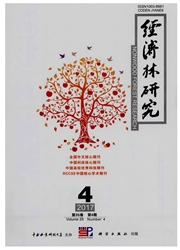

 中文摘要:
中文摘要:
为了探明扁桃花蕾的低温应激反应机制,以鹰咀扁桃大蕾期花蕾为试验材料,对花蕾进行4、-2、-4和-6℃低温处理,每6 h取样1次,观测24 h内花药、鳞片、花萼和花瓣4个部位可溶性糖含量、淀粉含量变化,分析比较花药、鳞片、花萼和花瓣4个部位的低温应激反应及抗寒性。结果发现,随着温度降低、时间延长,可溶性糖含量先升高后降低再升高;淀粉含量先降低后升高;总糖含量先升高后降低再升高;可溶性糖/总糖值先升高后降低。花药、花瓣和花萼在-2℃处理下24 h、-4℃处理下18 h和-6℃处理下12 h即有明显的低温应激反应发生,鳞片在-4℃处理下18 h和-6℃处理下12 h才有明显的低温应激反应发生。4个部位的低温应激反应程度由强到弱依次是花药、花瓣、花萼、鳞片,抗寒性由弱到强依次是花药、花瓣、花萼、鳞片。
 英文摘要:
英文摘要:
In order to explore the mechanism of low temperature stress reaction of almond flower buds, taking flower buds in Yingzui almond at the big flower bud period as experimental materials, the flower buds were treated under the low temperatures of 4, -- 2, -- 4 and -- 6 ℃. The samples were taken out at an interval of 6 hours, and changes of soluble sugar and starch contents in the four parts of anthers, scales, sepals and petals were observed during 24 hours, and their low temperature stress reaction and cold resistance were analyzed. The results showed that both soluble sugar content and total sugar content experienced the increased-decreased-increased change as temperature decreased and duration prolonged, starch content was decreased firstly and then increased, and ratio of soluble sugar content to total sugar content was increased firstly and then decreased. The anthers, petals and sepals had obvious reaction to low temperature stress under the treatment of -- 2 ℃ for 24 hours, -- 4 ℃ for 18 hours, and -- 6 ℃ for 12 hours, while the scales only had an obvious reaction to low temperature stress under the treatment of -- 4 ℃ for 18 hours or -- 6 ℃ for 12 hours. Based on low temperature stress reaction degrees from strong to weak, the order of the four parts was anthers, petals, sepals, scales, while based on cold resistance from weak to strong, the order of the four parts was anthers, petals, sepals, scales.
 同期刊论文项目
同期刊论文项目
 同项目期刊论文
同项目期刊论文
 期刊信息
期刊信息
